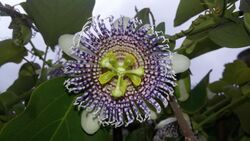Biology:Passiflora actinia
| Passiflora actinia | |
|---|---|

| |
| Scientific classification | |
| Kingdom: | Plantae |
| Clade: | Tracheophytes |
| Clade: | Angiosperms |
| Clade: | Eudicots |
| Clade: | Rosids |
| Order: | Malpighiales |
| Family: | Passifloraceae |
| Genus: | Passiflora |
| Species: | P. actinia
|
| Binomial name | |
| Passiflora actinia Hook.
| |
| Synonyms | |
|
P. paulensis Killip[1] | |
Passiflora actinia, also known as the sea anemone passion flower is a species of passion flower (passionfruit) of the Passifloraceae. It flowers mainly in early spring, producing white, mauve (purple), and blue flowers about 9 cm wide.[1]
Passiflora actinia is an evergreen vine. Native to Brazil, it is a relatively cold tolerant passion flower, and can be seen in gardens in England. Its edible fruit (a passionfruit) is golden orange when ripe, and about 10 cm long.[1] Passion fruit is a good source of nutrients, especially fiber, vitamin C, and provitamin A.
A single purple passion fruit contains (1Trusted Source):
- Calories: 17
- Fiber: 2 grams
- Vitamin C: 9% of the Daily Value (DV)
- Vitamin A: 8% of the DV
- Iron: 2% of the DV
- Potassium: 2% of the D
Its specific name might be in reference to the scientific name of the sea anemones (Actiniara),[2] since it resembles one.
References
- ↑ 1.0 1.1 1.2 Ulmer, Torsten (2004). Passiflora. Portland: Timber Press. ISBN 0-88192-648-5.
- ↑ "Actinia". https://www.merriam-webster.com/dictionary/actinia.
External links
Wikidata ☰ Q15497435 entry
 |

